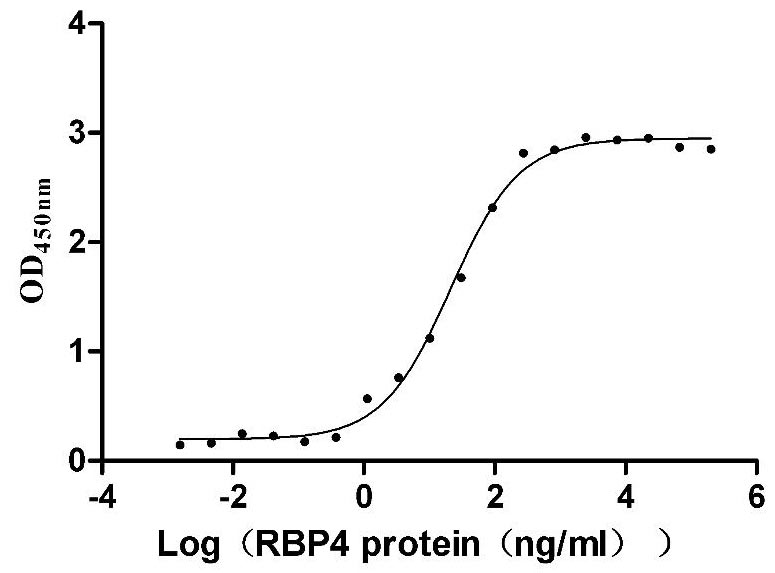Recombinant Human Geranylgeranyl pyrophosphate synthase (GGPS1)
-
货号:CSB-YP009393HU
-
规格:
-
来源:Yeast
-
其他:
-
货号:CSB-EP009393HU-B
-
规格:
-
来源:E.coli
-
共轭:Avi-tag Biotinylated
E. coli biotin ligase (BirA) is highly specific in covalently attaching biotin to the 15 amino acid AviTag peptide. This recombinant protein was biotinylated in vivo by AviTag-BirA technology, which method is BriA catalyzes amide linkage between the biotin and the specific lysine of the AviTag.
-
其他:
-
货号:CSB-BP009393HU
-
规格:
-
来源:Baculovirus
-
其他:
-
货号:CSB-MP009393HU
-
规格:
-
来源:Mammalian cell
-
其他:
产品详情
-
纯度:>85% (SDS-PAGE)
-
基因名:GGPS1
-
Uniprot No.:
-
别名:(2E; 6E)-farnesyl diphosphate synthase; Dimethylallyltranstransferase; Farnesyl diphosphate synthase; Farnesyltranstransferase; Geranylgeranyl diphosphate synthase 1; Geranylgeranyl diphosphate synthase; Geranylgeranyl pyrophosphate synthase; Geranylgeranyl pyrophosphate synthetase; Geranyltranstransferase; GGPP synthase; GGPP synthetase; GGPPS; GGPPS_HUMAN; GGPPS1; GGPPSase; GGPS1; OTTHUMP00000036073; OTTHUMP00000216161; OTTHUMP00000216163; OTTHUMP00000216164
-
种属:Homo sapiens (Human)
-
蛋白长度:Full length protein
-
表达区域:1-300
-
氨基酸序列MEKTQETVQR ILLEPYKYLL QLPGKQVRTK LSQAFNHWLK VPEDKLQIII EVTEMLHNAS LLIDDIEDNS KLRRGFPVAH SIYGIPSVIN SANYVYFLGL EKVLTLDHPD AVKLFTRQLL ELHQGQGLDI YWRDNYTCPT EEEYKAMVLQ KTGGLFGLAV GLMQLFSDYK EDLKPLLNTL GLFFQIRDDY ANLHSKEYSE NKSFCEDLTE GKFSFPTIHA IWSRPESTQV QNILRQRTEN IDIKKYCVHY LEDVGSFEYT RNTLKELEAK AYKQIDARGG NPELVALVKH LSKMFKEENE
-
蛋白标签:Tag type will be determined during the manufacturing process.
The tag type will be determined during production process. If you have specified tag type, please tell us and we will develop the specified tag preferentially. -
产品提供形式:Lyophilized powder
Note: We will preferentially ship the format that we have in stock, however, if you have any special requirement for the format, please remark your requirement when placing the order, we will prepare according to your demand. -
复溶:We recommend that this vial be briefly centrifuged prior to opening to bring the contents to the bottom. Please reconstitute protein in deionized sterile water to a concentration of 0.1-1.0 mg/mL.We recommend to add 5-50% of glycerol (final concentration) and aliquot for long-term storage at -20℃/-80℃. Our default final concentration of glycerol is 50%. Customers could use it as reference.
-
储存条件:Store at -20°C/-80°C upon receipt, aliquoting is necessary for mutiple use. Avoid repeated freeze-thaw cycles.
-
保质期:The shelf life is related to many factors, storage state, buffer ingredients, storage temperature and the stability of the protein itself.
Generally, the shelf life of liquid form is 6 months at -20°C/-80°C. The shelf life of lyophilized form is 12 months at -20°C/-80°C. -
货期:Delivery time may differ from different purchasing way or location, please kindly consult your local distributors for specific delivery time.Note: All of our proteins are default shipped with normal blue ice packs, if you request to ship with dry ice, please communicate with us in advance and extra fees will be charged.
-
注意事项:Repeated freezing and thawing is not recommended. Store working aliquots at 4°C for up to one week.
-
Datasheet :Please contact us to get it.
相关产品
靶点详情
-
功能:Catalyzes the trans-addition of the three molecules of IPP onto DMAPP to form geranylgeranyl pyrophosphate, an important precursor of carotenoids and geranylated proteins.
-
基因功能参考文献:
- results may support a model in which accumulation of susceptibility variants (including some in relevant genes, notably GGPS1) may lead to a possible genetic component of predisposition to atypical femoral fractures. PMID: 28467865
- GGPPS1 may play a critical role during the development of HCC from cirrhosis and is of clinical significance for predicting biological character of HCC. PMID: 24716791
- Egr-1 most likely does not induce the constitutive activation of Erk1/2 through its target gene GGPS1. PMID: 23478574
- the Egr-1/GGPPS/Erk1/2 pathway is responsible for insulin resistance during hyperinsulinism PMID: 21321112
- these results reveal a new EGR-1/GGPPS/MAPK signaling pathway that controls cigarette smoke-induced pulmonary inflammation. PMID: 21224049
- Study suggested that GGPS1 -8188A ins/del polymorphism may confer susceptibility to femoral neck BMD response to bisphosphonate therapy in Korean women. PMID: 20191015
- crystal structure; it reveals that three dimers join together to form a propeller-bladed hexameric molecule with a mass of approximately 200 kDa PMID: 16698791
- Farnesyltranstransferase mutations are associated with lonafarnib resistance PMID: 17536018
- results indicate that the active form of GGPS in the solution is an octamer rather than hexamer or dimer PMID: 17646172
- Evidence for a non-membrane bound isoform of geranylgeranyl diphosphate synthase 1 in rat. PMID: 8419360
显示更多
收起更多
-
亚细胞定位:Cytoplasm.
-
蛋白家族:FPP/GGPP synthase family
-
组织特异性:Abundantly expressed in testis. Found in other tissues to a lower extent.
-
数据库链接:
HGNC: 4249
OMIM: 606982
KEGG: hsa:9453
STRING: 9606.ENSP00000282841
UniGene: Hs.730768
Most popular with customers
-
Recombinant Human Intestinal-type alkaline phosphatase (ALPI) (Active)
Express system: Mammalian cell
Species: Homo sapiens (Human)
-
Recombinant Mouse Transthyretin (Ttr) (Active)
Express system: Mammalian cell
Species: Mus musculus (Mouse)
-
Recombinant Human Claudin-4 (CLDN4)-VLPs (Active)
Express system: Mammalian cell
Species: Homo sapiens (Human)
-
Recombinant Macaca fascicularis CD93 molecule (CD93), partial (Active)
Express system: Mammalian cell
Species: Macaca fascicularis (Crab-eating macaque) (Cynomolgus monkey)
-
Recombinant Human Glucagon-like peptide 1 receptor (GLP1R), partial (Active)
Express system: Mammalian cell
Species: Homo sapiens (Human)
-
Recombinant Human Cell adhesion molecule 1 (CADM1), partial (Active)
Express system: Mammalian cell
Species: Homo sapiens (Human)
-
Recombinant Human Serotransferrin(TF) (Active)
Express system: Mammalian cell
Species: Homo sapiens (Human)
-
Recombinant Human Dipeptidase 3(DPEP3), partial (Active)
Express system: Mammalian cell
Species: Homo sapiens (Human)




















